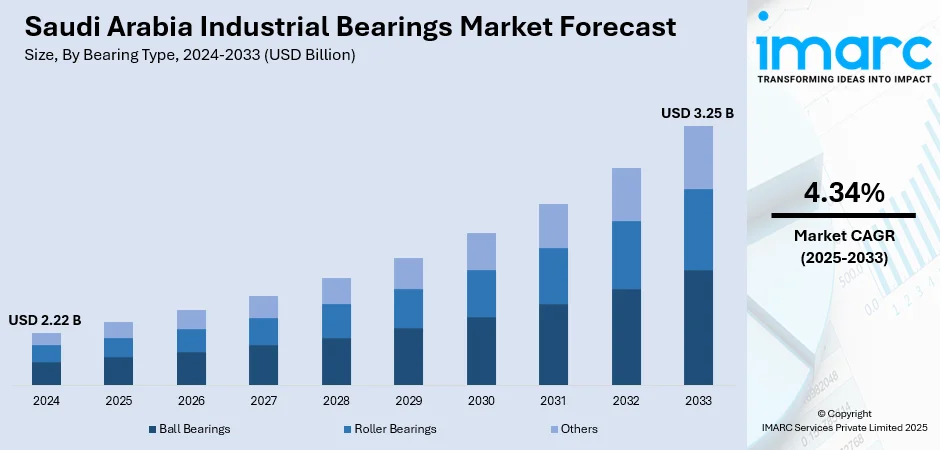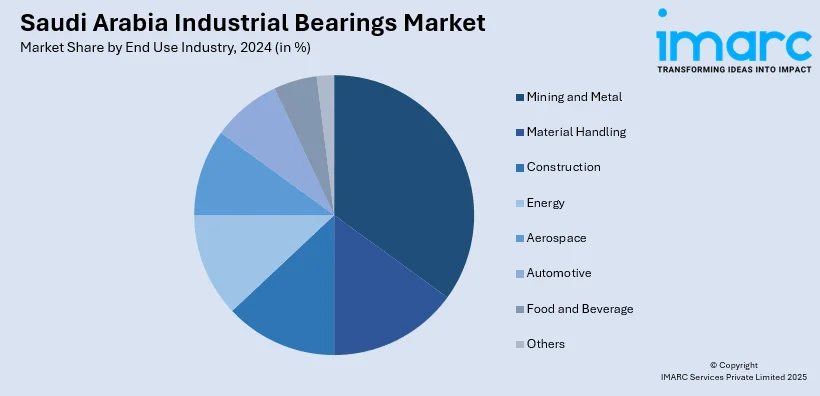
Saudi Arabia Industrial Bearings Market Size, Share, Trends and Forecast by Bearing Type, End Use Industry, and Region, 2025-2033
Saudi Arabia Industrial Bearings Market Overview:
The Saudi Arabia industrial bearings market size reached USD 2.22 Billion in 2024. Looking forward, IMARC Group expects the market to reach USD 3.25 Billion by 2033, exhibiting a growth rate (CAGR) of 4.34% during 2025-2033. Increased infrastructure, renewable energy projects, and initiatives to boost manufacturing and transportation sectors contribute to the growing need for reliable, efficient bearings across industries. Additionally, the Vision 2030, expansion in energy, and government support for industrial growth are contributing to the expansion of the Saudi Arabia industrial bearings market share.
|
Report Attribute
|
Key Statistics
|
|---|---|
|
Base Year
|
2024 |
|
Forecast Years
|
2025-2033
|
|
Historical Years
|
2019-2024
|
| Market Size in 2024 | USD 2.22 Billion |
| Market Forecast in 2033 | USD 3.25 Billion |
| Market Growth Rate 2025-2033 | 4.34% |
Saudi Arabia Industrial Bearings Market Trends:
Increase in Infrastructure Development
Saudi Arabia’s Vision 2030 initiative, aimed at diversifying the economy and decreasing dependence on oil, is resulting in a notable increase in the industrial endeavors. In this transformation, Saudi Arabia is making significant investments in infrastructure development, encompassing factories, energy facilities, and transport systems. This growth is driving the need for superior bearings utilized in machinery, heavy machinery, and production systems, guaranteeing seamless and effective operations across various sectors. Bearings play a vital role in minimizing machine downtime and improving productivity, making them crucial elements in these advancements. An instance is the SAR3 billion ($798 million) road infrastructure initiative declared by Saudi Arabia’s Roads General Authority (RGA) in 2024 for the Riyadh area. This initiative, with 23 finished projects and 66 in progress, aimed to enhance connectivity and traffic safety, benefiting crucial sectors like logistics, tourism, and trade, which depend on cutting-edge technologies and high-efficiency equipment that necessitate dependable bearings.

To get more information on this market, Request Sample
Expansion of Energy Sector
With Saudi Arabia’s transition towards diversifying its energy sources, the need for dependable bearings in turbines, compressors, and various mechanical systems utilized in both conventional and renewable energy initiatives is increasing. The functioning and upkeep of oil platforms, refineries, and petrochemical facilities demand high-performance bearings to guarantee effective machinery operation in extreme environments. Moreover, Saudi Arabia is putting money into renewable energy initiatives, which increases the need for high-performance bearings. An important instance is the 2024 pact between TotalEnergies and Aljomaih Energy & Water Company with Saudi Power Procurement Company for the 300 MW Rabigh 2 solar initiative. This initiative, part of Saudi Arabia’s National Renewable Energy Program, aligned with Vision 2030 objectives to enhance renewable energy capacity, emphasizing the increasing demand for specialized bearings in these changing energy systems.
Strong Government Support for Industrial Growth
The governing body support for industrial expansion, via incentives, subsidies, and strategic investments, significantly contributes to the Saudi Arabia industrial bearings market growth. Initiatives and efforts to draw foreign investments are accelerating the growth of sectors including manufacturing, construction, and transportation. This governmental support fosters a positive setting for the bearings industry, promoting sophisticated, regional manufacturing to satisfy increasing industrial demands. A demonstration of this effort is the 2024 declaration of new industrial projects, which featured an updated licensing framework, a customs exemption scheme, and the introduction of a digital industrial application to simplify investments and operations. The goal of these adjustments was to increase the number of factories to 36,000 and to triple industrial investments by the year 2035. With industries thriving due to these initiatives, the need for premium bearings in machinery, equipment, and production systems keeps increasing.
Saudi Arabia Industrial Bearings Market Segmentation:
IMARC Group provides an analysis of the key trends in each segment of the market, along with forecasts at the country and regional levels for 2025-2033. Our report has categorized the market based on bearing type and end use industry.
Bearing Type Insights:
- Ball Bearings
- Roller Bearings
- Others
The report has provided a detailed breakup and analysis of the market based on the bearing type. This includes ball bearings, roller bearings, and others.
End Use Industry Insights:

- Mining and Metal
- Material Handling
- Construction
- Energy
- Aerospace
- Automotive
- Food and Beverage
- Others
A detailed breakup and analysis of the market based on the end use industry have also been provided in the report. This includes mining and metal, material handling, construction, energy, aerospace, automotive, food and beverage, and others.
Regional Insights:
- Northern and Central Region
- Western Region
- Eastern Region
- Southern Region
The report has also provided a comprehensive analysis of all the major regional markets, which include Northern and Central Region, Western Region, Eastern Region, and Southern Region.
Competitive Landscape:
The market research report has also provided a comprehensive analysis of the competitive landscape. Competitive analysis such as market structure, key player positioning, top winning strategies, competitive dashboard, and company evaluation quadrant has been covered in the report. Also, detailed profiles of all major companies have been provided.
Saudi Arabia Industrial Bearings Market Report Coverage:
| Report Features | Details |
|---|---|
| Base Year of the Analysis | 2024 |
| Historical Period | 2019-2024 |
| Forecast Period | 2025-2033 |
| Units | Billion USD |
| Scope of the Report |
Exploration of Historical Trends and Market Outlook, Industry Catalysts and Challenges, Segment-Wise Historical and Future Market Assessment:
|
| Bearing Type Covered | Ball Bearings, Roller Bearings, Others |
| End Use Industries Covered | Mining and Metal, Material Handling, Construction, Energy, Aerospace, Automotive, Food and Beverage, Others |
| Regions Covered | Northern and Central Region, Western Region, Eastern Region, Southern Region |
| Customization Scope | 10% Free Customization |
| Post-Sale Analyst Support | 10-12 Weeks |
| Delivery Format | PDF and Excel through Email (We can also provide the editable version of the report in PPT/Word format on special request) |
Key Questions Answered in This Report:
- How has the Saudi Arabia industrial bearings market performed so far and how will it perform in the coming years?
- What is the breakup of the Saudi Arabia industrial bearings market on the basis of bearing type?
- What is the breakup of the Saudi Arabia industrial bearings market on the basis of end use industry?
- What is the breakup of the Saudi Arabia industrial bearings market on the basis of region?
- What are the various stages in the value chain of the Saudi Arabia industrial bearings market?
- What are the key driving factors and challenges in the Saudi Arabia industrial bearings market?
- What is the structure of the Saudi Arabia industrial bearings market and who are the key players?
- What is the degree of competition in the Saudi Arabia industrial bearings market?
Key Benefits for Stakeholders:
- IMARC’s industry report offers a comprehensive quantitative analysis of various market segments, historical and current market trends, market forecasts, and dynamics of the Saudi Arabia industrial bearings market from 2019-2033.
- The research report provides the latest information on the market drivers, challenges, and opportunities in the Saudi Arabia industrial bearings market.
- Porter's five forces analysis assist stakeholders in assessing the impact of new entrants, competitive rivalry, supplier power, buyer power, and the threat of substitution. It helps stakeholders to analyze the level of competition within the Saudi Arabia industrial bearings industry and its attractiveness.
- Competitive landscape allows stakeholders to understand their competitive environment and provides an insight into the current positions of key players in the market.
Need more help?
- Speak to our experienced analysts for insights on the current market scenarios.
- Include additional segments and countries to customize the report as per your requirement.
- Gain an unparalleled competitive advantage in your domain by understanding how to utilize the report and positively impacting your operations and revenue.
- For further assistance, please connect with our analysts.
 Request Customization
Request Customization
 Speak to an Analyst
Speak to an Analyst
 Request Brochure
Request Brochure
 Inquire Before Buying
Inquire Before Buying




.webp)




.webp)












